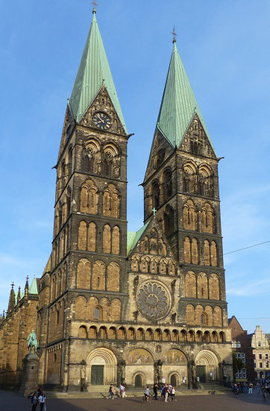The Saint Petri cathedral is a Romanic church made out of sandstone and bricks. The cathedral was built in the 11th century and was rebuilt in the style of gothic art until the 13th century. There were expansions around lateral chapels. In 1502 structural alteration works began, that changed the church into a late gothic hall church. The construction works stopped as the reformation began. In the late 19th century, extensive renovations of the strongly neglected construction started. They tried to keep the old form. Today, the Lord’s house belongs to the Evangelic-Lutheran cathedral parish St. Petri. Since 1973 the Saint Peters cathedral is declared a historic monument. The place on the site of today's Saint Peters cathedral, the highest point of the Weser dune in midst of the settlement has become the city core with the construction of the church. The construction was initiated by the Anglo-Saxon missionary bishop Willehad. The timber work was burnt and destructed in 792, 3 years after its completion in course of the Saxon war. After Willehad’s death in 798, there neither was a new bishop nor a cathedral in Bremen for 13 years. In 805 the construction of a new cathedral (out of stone) started under the direction of bishop Willerich. The construction dragged on for many years.

